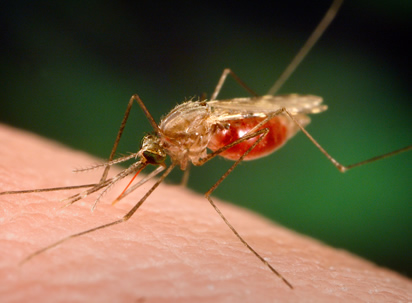The microbes in a mosquito’s gut may help fight malaria
 Two research teams have found that tinkering with mosquitoes’ resident microbes can help them spread resistance to the malaria parasite, according to a release to the Ghana News Agency.
Two research teams have found that tinkering with mosquitoes’ resident microbes can help them spread resistance to the malaria parasite, according to a release to the Ghana News Agency.
One research team used “weaponized” bacteria to deliver parasite-stopping proteins to mosquito guts. The other found that mosquitoes with a malaria-blocking gene have an unexpected mating advantage, thanks to their microbes.
Professor Omar Akbari, Molecular Biologist at the University of California, Riverside, said “I found both of [the studies] exciting in different ways. I really hope to see these technologies tested in the field.”
After biting a person infected with malaria, a female Anopheles mosquito harbours the malaria parasite—Plasmodium falciparum—in its gut.
Molecular entomologist Marcelo Jacobs-Lorena of Johns Hopkins University in Baltimore, Maryland, and colleagues have developed strains of genetically modified bacteria that fight the parasite and lower the chance that an insect will pass it on with its next bite.
But so far, it’s been hard to get these helpful bacteria to spread through a mosquito population.
Recently, a routine dissection turned serendipitous. Sibao Wang, a postdoc in Jacobs-Lorena’s lab, who has since moved to Chinese Academy of Sciences in Shanghai, found fluid in a mosquito ovary that seemed cloudy to him—a possible indicator that it harboured bacteria.
It said the bacterial variety he discovered, a new strain in the common genus Serratia, loved to spread. When female Anopheles gambiae mosquitoes ate sugar laced with the Serratia, it quickly populated their guts.
The bacterium appeared on the surface of their eggs, and even spread to the larvae when they hatched. And it could also be transmitted sexually from males to females.
The microbe seemed to have no negative effects, so the researchers equipped it with anti-Plasmodium genes. They engineered it to produce five molecules with different methods of killing, trapping, or hobbling Plasmodium in the gut.
In mosquitoes fed the genetically engineered bacterium 2 days before drinking Plasmodium-infected blood, the researchers detected about 93 percent fewer parasites than in their untreated counterparts. The results are published online today in Science.
“I had been one of the people who was pretty skeptical that this could work,” says Fred Gould, an evolutionary biologist at North Carolina State University in Raleigh. That’s in part because it’s hard to get a bacterium to thrive in the competitive environment of the gut, he says, and to stick with the mosquitoes as they grow from larvae to adults.
“But it looks like they’re making some interesting progress here.”
It remains to be seen whether the mosquitoes will share the bacterium as readily in the wild as they do in a lab.
Jacobs-Lorena’s team is preparing an enclosure at a facility in southern Zambia—complete with “vegetation and flowers and a little hut,” he says—to test transmission in a more realistic setting.
Another team, also based at Johns Hopkins, is chasing a different approach to malaria control.
Mosquito vector biologist George Dimopoulos and colleagues have endowed the malaria-spreading A. stephensi mosquito with a gene that increases production of a protein called Rel2, which helps block infection in its gut. The gene seems to give the mosquito a competitive advantage in mating and passing on its genes, the team reports in another Science paper today.
The team traced that advantage to changes Rel2 makes to the mosquito’s gut microbiome, which could affect the way the insect smells to a potential mate, Dimopoulos says.
The experiments revealed a surprising preference for opposites: Genetically modified males were more likely to mate with unmodified females, whereas unmodified males preferred modified females. That sped up the gene’s spread through the caged population: When equal numbers of modified and unmodified mosquitoes shared a cage, about 90 percent of their next generation carried the Rel2 gene, and that proportion persisted for 10 generations.
“I don’t think anyone would have ever expected that,” Gould says.
Dimopoulos believes the use of genetic modifications to drive mating preferences could offer a more “natural” and “subtle” way to spread an anti-Plasmodium gene than other approaches.
Those include gene drive technologies meant to increase the likelihood a gene will be passed to the next generation—sometimes using CRISPR gene editing. That approach shows promise as a malaria control strategy, but it has also sparked worries that it will be unpredictable and hard to control.
The CRISPR-based methods do involve putting more complicated molecular machinery into cells, Akbari says, but they could also prove more reliable than the new approach, which relies on complex mating dynamics. “I think gene drive is probably a more powerful technology that’s portable across species,” he says.
The teams behind both Science papers don’t express a fear of competition; indeed, they expect their approaches to be combined. And as efforts to combat malaria with insecticides come up short, the field is hungry for new methods.
These papers offer “imaginative ways” to manipulate mosquito microbes for disease control, says population geneticist Jeffrey Powell of Yale University.
“Developing a diverse set of tools to control malaria transmission is the only hope of success.”
Source: GNA
